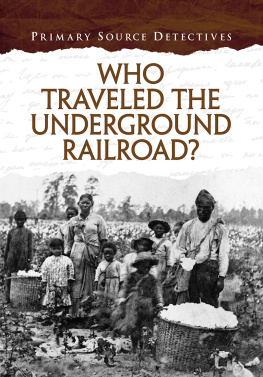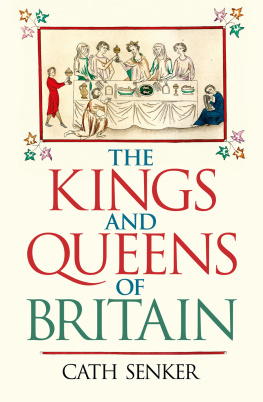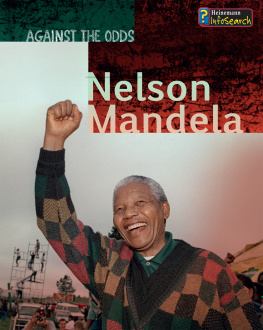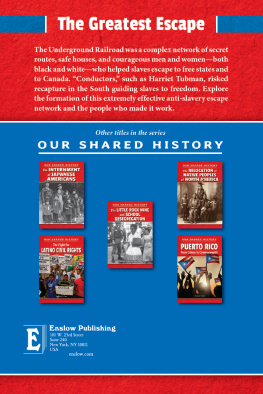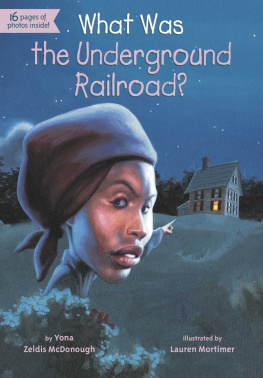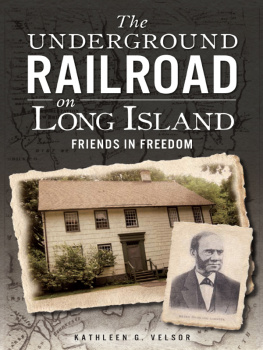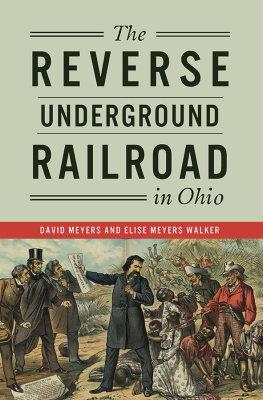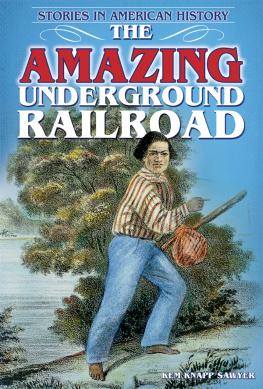FIND OUT MORE
BOOKS
Nonfiction
Cosson, M. J. Harriet Tubman (Essential Lives). Edina, Minn.: ABDO, 2008.
Fradin, Dennis B., and Judith Bloom Fradin. The Price of Freedom: How One Town StoodUp to Slavery . New York: Walker Books for Young Readers, 2013.
Spilsbury, Richard. Slavery and the Slave Trade (Research It!). Chicago: HeinemannLibrary, 2010.
Sterngrass, John. Frederick Douglass (Leaders of the Civil War Era). New York: ChelseaHouse, 2009.
Fiction
Ayres, Katherine. North by Night: A Story of the Underground Railroad . New York:Dell Yearling, 2000.
Cole, Henry. Unspoken: A Story from the Underground Railroad . New York: Scholastic,2012 .
Martin, Faith Reese. Ghost Train to Freedom: An Adventure on the Underground Railroad .Lancaster, Pa.: American Literary, 2012.
Plaxton, Judith. Morning Star . Toronto: Second Story, 2011.
WEB SITES
education.nationalgeographic.com/education/multimedia/interactive/did-you-know-the-underground-railroad/?ar_a=1
Basic information about the Underground Railroad, including an interactive journey,can be found on this National Geographic site.
www.freedomcenter.org/underground-railroad-0
The National Underground Railroad Freedom Center has a useful overview of the UndergroundRailroad and information about modern-day slavery.
johnparkerhouse.org
The John P. Parker Museum and Historical Society web site has details about abolitionistJohn Parker and a clip from a film about him.
www.loc.gov/library/libarch-digital.html
The Library of Congress Digital Collections can be viewed online.
www.nps.gov/subjects/ugrr/education/upload/Junior-Ranger-ActivityBooklet.pdf
Try the activities in this booklet by the National Park Service about the UndergroundRailroad.
www.ohiohistorycentral.org/entry.php?rec=1518
Find out more about the people involved in the Underground Railroad in the borderstate of Ohio.
undergroundrailroadhistory.org
This web site is about the activities of the Underground Railroad History Project,which researches and preserves the history of the Underground Railroad.
OTHER TOPICS TO RESEARCH
You might like to investigate the story of Harriet Tubman, who has become a legendaryfigure of the Underground Railroad.
You may also want to find about the abolitionist movement, which was fighting toend slavery in the United States. Key members of the movement were Quakers, so youcould investigate their role in the ending of slavery.
A parallel story is the struggle for womens rights in the United States in the 19thcentury. Can you find out more about this topic?
PAGE 14 ANSWERS
- 1. Joe, I have two male fugitives and one mixed-race female fugitive at my house.
- 2. A large mixed-race Christian needs help; he will be in town on Tuesday afternoonand has $100 to pay his way.
A BID FOR FREEDOM
Charles Gilbert was a slave in the city of Richmond, Virginia. His master, BenjaminDavis, was eager to sell him for a good price. As Davis was plotting to sell Gilbert,the young man was planning his escape. He made contact with a ships captain, whopromised to transport him to freedom if he could make his way to Old Point Comfort,which was 160 miles (260 kilometers) from Richmond.
Many of Gilberts relatives lived in Old Point Comfort, so he knew his master wouldseek him there. He would have to lie low until the ships departure. He found a gloomyspot under a hotel where he hid for four weeks. He emerged only under the cover ofdarkness to gather food from the hotels slop tub, which contained the guests wastefood. One day, he was almost discovered by a boy. Gilbert barked like a dog to frightenaway the child. The trick worked, but he knew it was time to move on.
After spending a night up a tree, his next hiding place was at the of hisslave friend Isabella. Unable to stay with her openly, he lifted the floorboardsand hid underneath. Yet slave hunters came searching for him, so he fled back tothe hotel and then to the woods, where he again had to imitate a dog to avoid beingdetected. Meanwhile, Gilberts mother had heard her son was attempting escape; shesaved up some money, and a passage was booked for him on a steamer going to Philadelphia.Gilbert was overjoyed. He chose to spend his last night at Isabellas washhouse.

